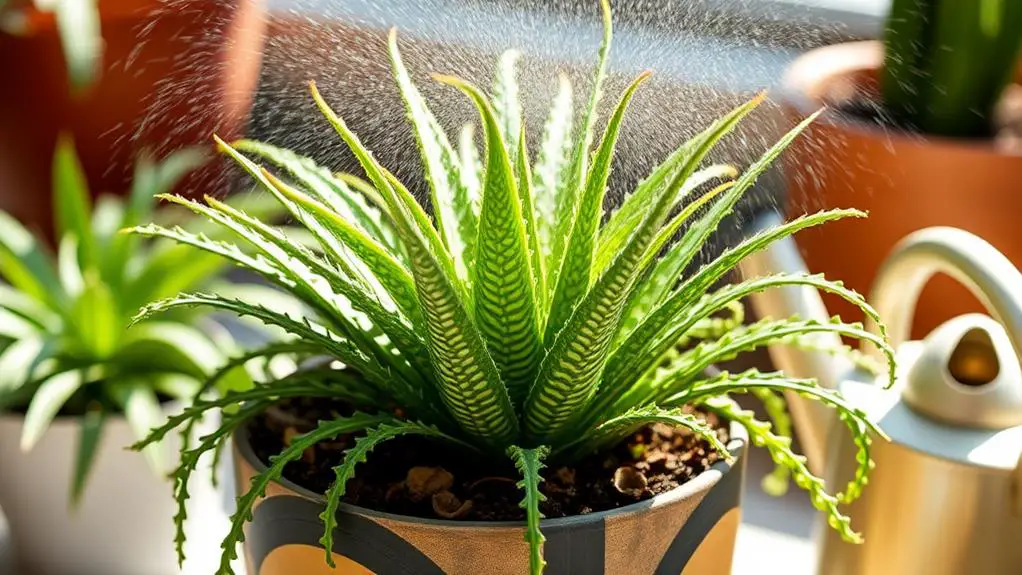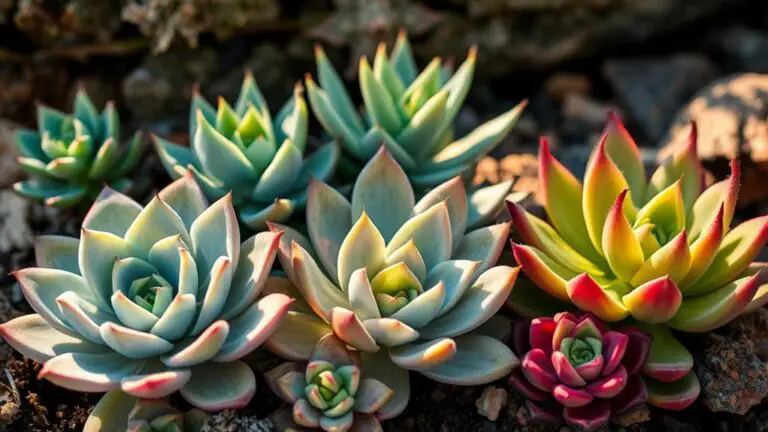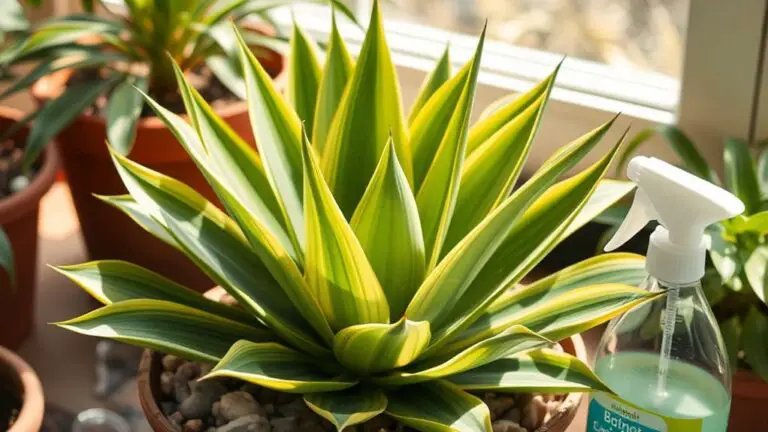7 Easy Steps to Care for Your Haworthia Cooperi
Caring for your Haworthia cooperi doesn't have to be complicated if you follow these seven straightforward steps. Start by ensuring it gets the right amount of light and maintaining an ideal temperature range. You'll need to water it correctly and use a well-draining soil mix to keep it healthy. Fertilizing sparingly and monitoring for pests are equally essential. Finally, knowing how to propagate it successfully will keep your plant thriving. So, where do you begin, and what are the specifics of each step? Let's explore each aspect in detail to see how easy it can be.
Choose the Right Light
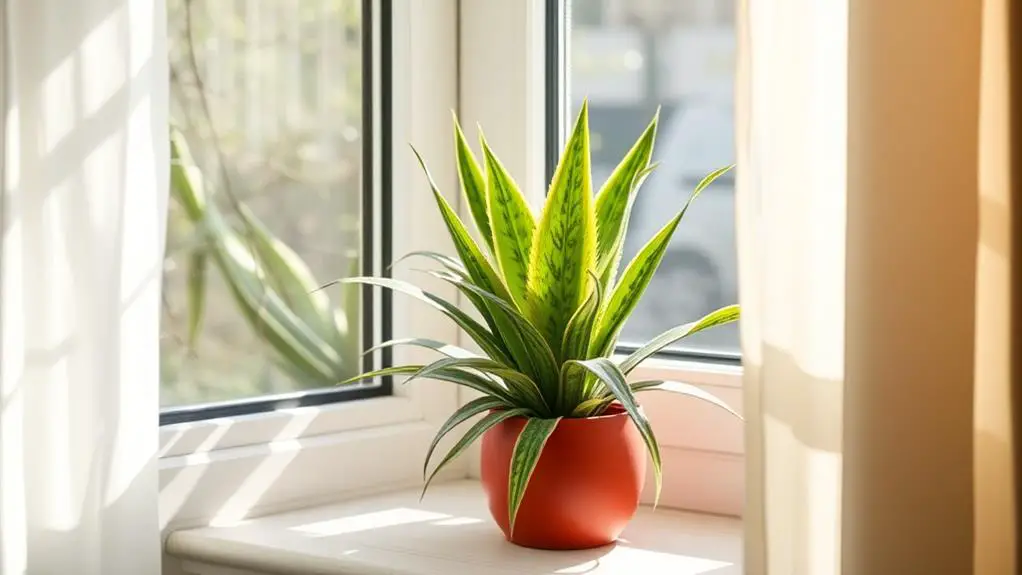
Choosing the right light is vital for keeping your Haworthia cooperi healthy and vibrant. This plant thrives in bright, indirect light for about 4 to 5 hours daily. Placing it near an east-facing window is perfect because it gets the gentle morning sun without harsh midday rays. A north-facing window can also work well, especially if your home doesn't get too much direct sunlight.
Direct sunlight can scorch the translucent leaves of your Haworthia cooperi, which may turn red and stressed. Always protect it from harsh sun exposure to avoid this. If you don't provide enough light, you might notice the plant grows leggy and stretches towards the light, a condition known as etiolation. This can make your plant look unhealthy.
To keep your Haworthia cooperi in peak condition, adjust its placement with the changing seasons to maintain proper light levels. Regularly monitor the plant to guarantee it's getting enough light. Insufficient light can lead to reduced flowering and slow growth.
On the flip side, too much light can cause leaf fading and damage.
With the right light, you'll reduce your watering needs and help prevent common pests. This care step is essential for a thriving and beautiful plant.
Maintain Ideal Temperature
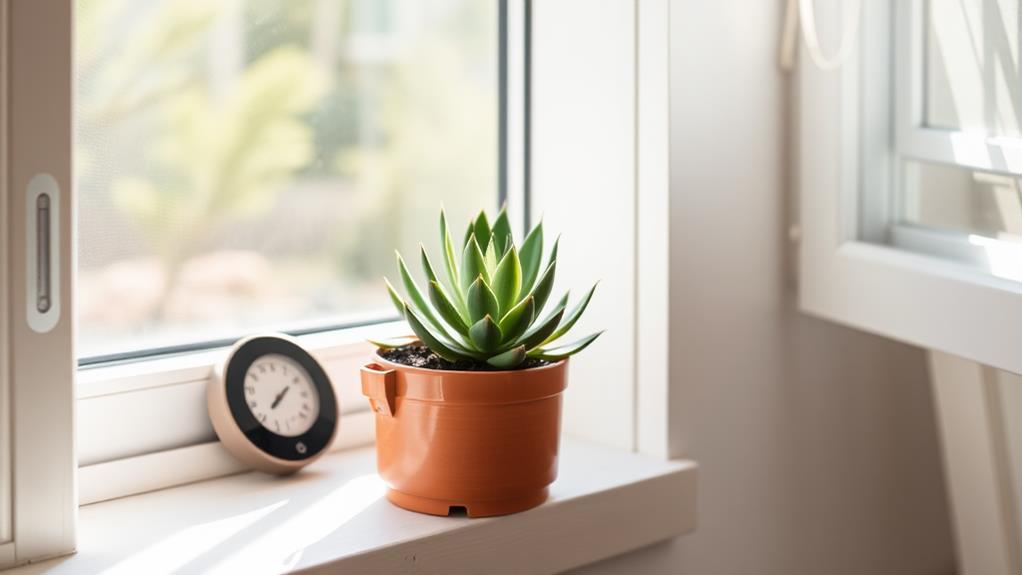
To keep your Haworthia cooperi happy, aim for temperatures between 60-80°F (15-27°C), which works well for most indoor settings.
Avoid extreme temperatures by keeping it away from drafts and heating vents, as sudden changes can stress the plant.
During warmer months, make sure it's in a well-ventilated spot to prevent overheating.
Optimal Temperature Range
Maintaining the ideal temperature range is fundamental for the health and growth of your Haworthia cooperi. For best growth, aim to keep it in indoor temperatures between 60-80°F (15-27°C). This range provides the perfect balance for your succulent to thrive.
While it can handle cooler temperatures at night, make certain it doesn't dip below 50°F (10°C) for too long, as this can cause stress and damage to your plant.
Stable temperatures are key, so try to avoid placing your Haworthia cooperi in spots with drafts or sudden temperature changes. Such fluctuations can negatively impact its growth and overall health.
During the fall and winter months, especially if you live in cooler regions, it's best to keep your plant indoors to prevent any frost damage.
Regularly check the temperature around your Haworthia cooperi to confirm it stays within the ideal range. Doing so will promote healthy leaf development and keep your plant vibrant.
Remember, a consistent environment is significant for the health of your Haworthia cooperi, so take these steps to create a stable and nurturing home for it.
With proper care, your plant will flourish beautifully.
Avoid Extreme Temperatures
Beyond maintaining the perfect temperature range, it's equally important to avoid extreme temperatures for your Haworthia cooperi. This succulent thrives best between 60°F to 80°F (15°C to 27°C) for ideal growth and health. If temperatures drop to 50°F (10°C) for a short time, your plant might be okay, but prolonged exposure can stress it out and slow its development.
Avoid placing your Haworthia cooperi in drafty areas or near heating and cooling vents. Sudden temperature changes from these spots can negatively impact its health. Remember, Haworthia cooperi is not frost-tolerant. If you live in a place with cold winters, keep your plant indoors to protect it from freezing temperatures.
Maintaining consistent temperatures will help your succulent experience vigorous growth and enhance its overall well-being. Here's a quick guide:
| Temperature | Impact on Haworthia cooperi |
|---|---|
| 60°F – 80°F (15°C – 27°C) | Ideal growth and health |
| Around 50°F (10°C) | Tolerable for short periods, but stressful |
| Below 50°F (10°C) | Risk of stress and hindered development |
| Frost conditions | Potential damage, not frost-tolerant |
| Near vents/drafts | Sudden changes, negative impact on health |
Keep these tips in mind to help your Haworthia cooperi thrive!
Water Appropriately
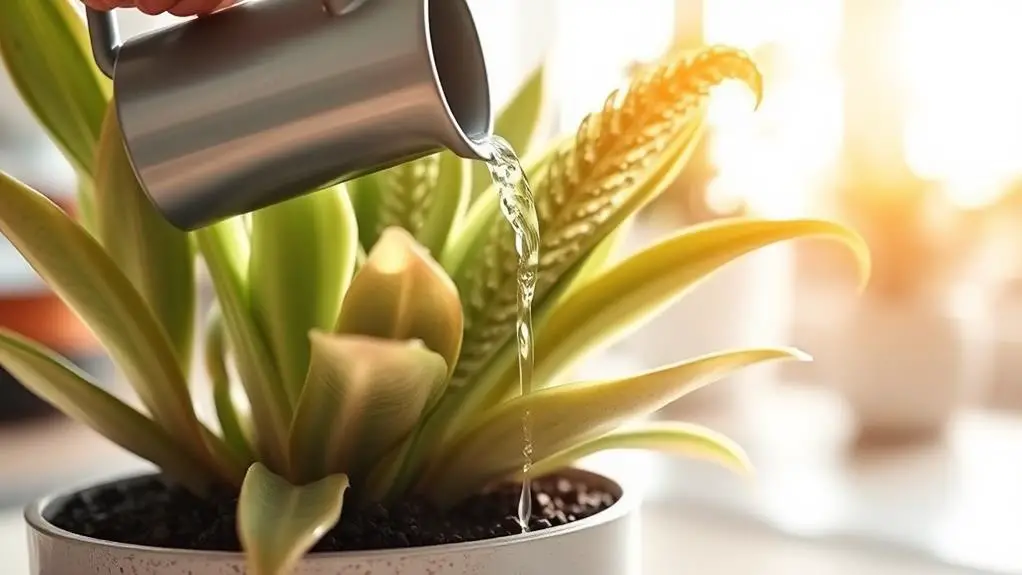
To water your Haworthia cooperi properly, make sure the top 2 inches of soil are completely dry before adding water.
During the growing season, you'll likely water every 2-3 weeks, but reduce this to once a month or less in fall and winter.
Always let the plant dry out between waterings to prevent root rot and use room temperature water to avoid stressing the plant.
Ensure Soil Dryness
When caring for your Haworthia cooperi, it's crucial to let the soil dry out completely between waterings to avoid root rot. This succulent thrives with a careful watering schedule, so you'll want to be attentive to its needs.
To care for Haworthia cooperi properly, follow these steps:
- Check soil moisture: Use the finger test by inserting your finger into the top 2 inches of soil. If it feels dry, it's time to water. This helps guarantee the soil dries out completely before the next watering.
- Water sparingly: Typically, water your Haworthia cooperi every 2-3 weeks during the growing season and reduce to once a month in fall and winter. Aim for approximately 0.5 cups of water every 12 days, adjusting based on your environment's humidity and temperature.
- Guarantee proper drainage: Make sure your pot has adequate drainage holes. These holes allow excess water to escape, preventing it from accumulating in the soil and causing root rot.
When you water, focus on the soil directly, avoiding the leaves and the plant's center. This prevents water from sitting in the plant's rosette, which can also lead to rot.
Seasonal Water Adjustments
While guaranteeing soil dryness is key to preventing root rot, it's equally important to adjust your watering schedule based on the season. During the growing season, which includes spring and summer, you should water your Haworthia cooperi approximately every 2-3 weeks. Always let the soil dry completely between waterings to avoid overwatering. This succulent thrives with a specific balance of moisture, so take care to check the top 2 inches of soil for dryness before each watering.
As the season changes to fall and winter, reduce watering frequency to once a month or even less. During this dormant phase, your Haworthia cooperi needs much less moisture. Overwatering during this time can lead to root rot, so be cautious.
Environmental conditions also play a role; if it's hot and dry, you may need to water a bit more often. Conversely, during cooler, more humid periods, you should cut back.
When you do water, use room temperature water to avoid shocking the plant. Ascertain that any excess water drains out of the pot, keeping the roots healthy.
Prevent Root Rot
Preventing root rot in your Haworthia cooperi starts with proper watering techniques. First, allow the soil to dry out completely between waterings. During the growing season, you should water every 2-3 weeks. When fall and winter come, reduce this to once a month. This helps prevent water accumulation around the roots, which can lead to rot.
To further guarantee your Haworthia cooperi gets the best care, use a well-draining cactus or succulent soil mix. This type of soil helps excess water escape quickly, reducing the risk of root rot. You can check the moisture level by sticking your finger into the soil. Only water when the top 2 inches are dry to the touch.
Consider the pot you use as well. A shallow pot with ample drainage holes is ideal. This allows any extra water to drain out, keeping the roots from sitting in water.
Here are three key points to remember:
- Let soil dry completely between waterings.
- Use well-draining succulent soil.
- Choose a pot with drainage holes.
Use Well-Draining Soil
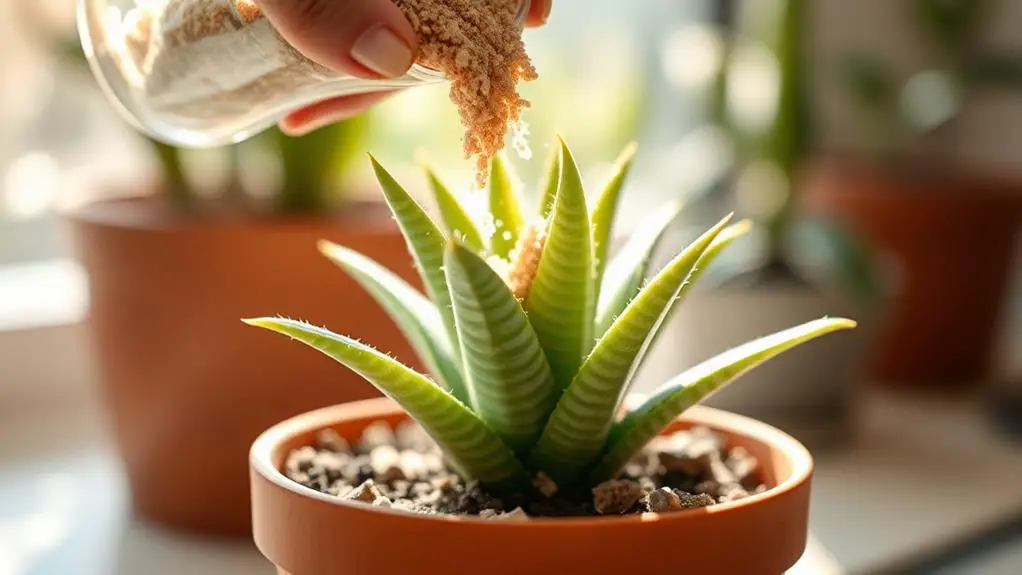
To guarantee your Haworthia cooperi thrives, it's essential to use a well-draining soil mix. Standard potting soil retains too much moisture and can lead to root rot. Instead, create a mix using equal parts potting soil, perlite, and coarse sand or pumice. This combination guarantees excellent aeration and drainage, providing the perfect environment for your plant's roots.
Avoid using fine sand, as it compacts and hinders drainage. Larger particles like coarse sand or pumice promote airflow and prevent water from accumulating around the roots.
When repotting your Haworthia cooperi, make certain the new pot has ample drainage holes. This step is indispensable to prevent excess water from sitting in the pot, which could damage the plant.
Checking the soil's moisture level is also important. Insert your finger into the top 2 inches of soil; if it feels dry, it's time to water. Proper watering is part of the care required to keep your Haworthia cooperi healthy.
Fertilize Sparingly

When it comes to fertilizing your Haworthia cooperi, less is more. This low-maintenance plant isn't a heavy feeder and can thrive without much fertilization. However, if you choose to fertilize, it's important to do so sparingly to avoid stressing the plant.
To keep your Haworthia cooperi healthy, follow these tips:
- Use a half-strength, low-nitrogen succulent or cactus fertilizer at the beginning and end of the growing season.
- Repot every few years with fresh potting medium to provide adequate nutrients without the need for frequent fertilization.
- Watch for signs of nutrient deficiencies, like yellowing leaves, but approach any nutrient boost cautiously to avoid over-fertilization.
Over-fertilizing can lead to signs of stress, such as brown or yellow leaves, and can hinder your plant's growth.
By fertilizing sparingly, you guarantee your Haworthia cooperi remains healthy and vibrant. A fresh potting medium every few years gives your plant fresh nutrients it needs without overwhelming it.
Monitor for Pests
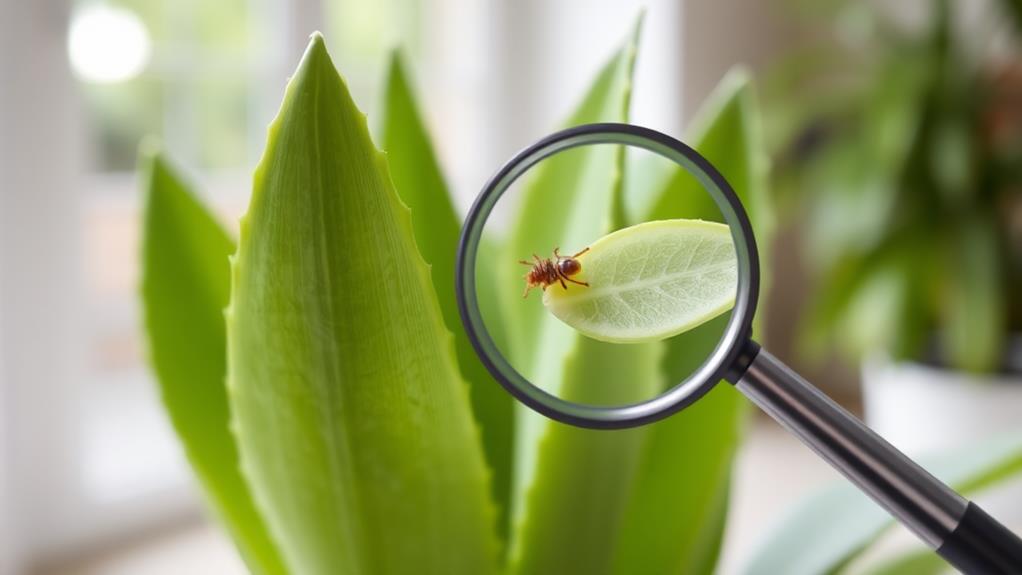
After guaranteeing your Haworthia cooperi gets just the right amount of fertilizer, the next step in its care involves keeping an eye out for pests.
You'll want to regularly inspect the leaves and soil for signs of unwanted visitors like mealybugs and spider mites. These pests can compromise the health of your plant and cause problems like yellowing leaves or stunted growth.
If you spot mealybugs, don't worry. Treat them promptly with some rubbing alcohol on a cotton swab or by using neem oil. Both methods are effective and can prevent infestations from spreading.
When it comes to spider mites, you might notice fine webbing on your plant. These pests thrive in dry conditions, so increasing humidity levels slightly can help deter them.
Maintaining good airflow around your Haworthia cooperi is also essential. Make sure it's not overcrowded with other plants. This will reduce the risk of pest infestations and promote overall health.
Propagate Successfully
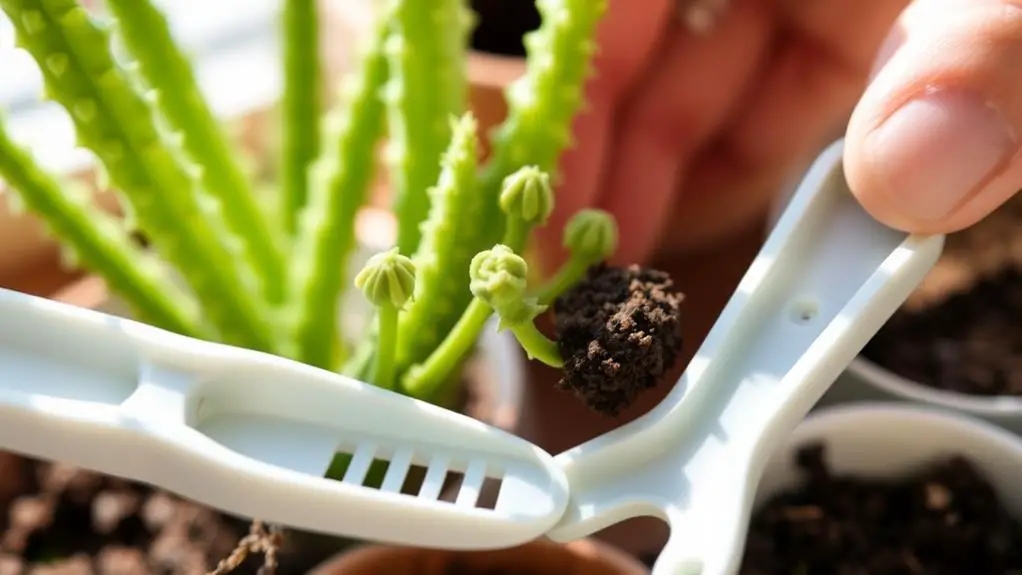
Successfully propagating your Haworthia cooperi can be a rewarding endeavor that guarantees you have more of these charming succulents in your collection. To get started, you'll need to focus on a few important steps.
- Remove Offsets: Look for small rosettes at the base of the parent plant. Carefully separate these offsets, making sure they've developed roots before you remove them. This helps guarantee the new plants will thrive.
- Leaf Cuttings: Choose a healthy outer leaf from your Haworthia. Twist it gently to get a clean break, then let the cut end callous for a few days. Once calloused, plant it upright in a well-draining soil mix. This helps in healthy root development.
- Timing and Care: Propagation works best during the growing season, typically spring and summer.
Keep the soil moisture balanced by lightly misting the soil until roots establish. This can take anywhere from several weeks to a few months.
Watch for signs of distress like wilting or discoloration and adjust your care practices accordingly.
Frequently Asked Questions
How to Take Care of Haworthia Cooperi?
Place your Haworthia cooperi in bright, indirect light. Water every 2-3 weeks, allowing the soil to dry out. Use well-draining soil and keep temperatures between 60-80°F. Fertilize sparingly with low-nitrogen fertilizer at the season's start and end.
How Do You Care for Indoor Haworthia?
Place your Haworthia cooperi near a north or east-facing window for bright, indirect sunlight. Water sparingly, allowing soil to dry out. Maintain temperatures between 60-80°F. Use well-draining soil and fertilize lightly during growing seasons.
How to Revive Haworthia Cooperi?
To revive your Haworthia cooperi, let the soil dry out if it's too wet, trim decayed roots, and repot in fresh, well-draining soil. Guarantee bright, indirect light and treat any pests with rubbing alcohol or neem oil.
Do You Water Haworthia From the Top or Bottom?
You should water your Haworthia cooperi from the bottom. Place the pot in a shallow dish of water for 15-30 minutes. Guarantee proper drainage to prevent rot. Avoid top watering to keep the plant's crown dry.
Conclusion
Taking care of your Haworthia cooperi is straightforward and rewarding. Just follow these seven steps and you'll see your plant thrive. Give it the right light, maintain a cozy temperature, water wisely, and use well-draining soil. Don't forget to fertilize sparingly, keep an eye out for pests, and propagate carefully. With a bit of attention and love, you'll have a healthy, happy Haworthia cooperi that brightens up your space. Happy gardening!

